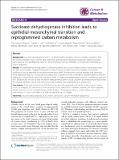| dc.contributor.author | Aspuria, Paul-Joseph P. | |
| dc.contributor.author | Lunt, Sophia Yunkyungkwon | |
| dc.contributor.author | Väremo, Leif | |
| dc.contributor.author | Vergnes, Laurent | |
| dc.contributor.author | Gozo, Maricel | |
| dc.contributor.author | Beach, Jessica A | |
| dc.contributor.author | Salumbides, Brenda | |
| dc.contributor.author | Reue, Karen | |
| dc.contributor.author | Wiedemeyer, W. R. | |
| dc.contributor.author | Nielsen, Jens Kromann | |
| dc.contributor.author | Karlan, Beth Y. | |
| dc.contributor.author | Orsulic, Sandra | |
| dc.date.accessioned | 2014-12-24T16:24:27Z | |
| dc.date.available | 2014-12-24T16:24:27Z | |
| dc.date.issued | 2014-12 | |
| dc.date.submitted | 2014-05 | |
| dc.identifier.issn | 2049-3002 | |
| dc.identifier.uri | http://hdl.handle.net/1721.1/92499 | |
| dc.description.abstract | Succinate dehydrogenase (SDH) is a mitochondrial metabolic enzyme complex involved in both the electron transport chain and the citric acid cycle. SDH mutations resulting in enzymatic dysfunction have been found to be a predisposing factor in various hereditary cancers. Therefore, SDH has been implicated as a tumor suppressor.
We identified that dysregulation of SDH components also occurs in serous ovarian cancer, particularly the SDH subunit SDHB. Targeted knockdown of Sdhb in mouse ovarian cancer cells resulted in enhanced proliferation and an epithelial-to-mesenchymal transition (EMT). Bioinformatics analysis revealed that decreased SDHB expression leads to a transcriptional upregulation of genes involved in metabolic networks affecting histone methylation. We confirmed that Sdhb knockdown leads to a hypermethylated epigenome that is sufficient to promote EMT. Metabolically, the loss of Sdhb resulted in reprogrammed carbon source utilization and mitochondrial dysfunction. This altered metabolic state of Sdhb knockdown cells rendered them hypersensitive to energy stress.
These data illustrate how SDH dysfunction alters the epigenetic and metabolic landscape in ovarian cancer. By analyzing the involvement of this enzyme in transcriptional and metabolic networks, we find a metabolic Achilles' heel that can be exploited therapeutically. Analyses of this type provide an understanding how specific perturbations in cancer metabolism may lead to novel anticancer strategies. | en_US |
| dc.description.sponsorship | Foundation for Women’s Cancer (Lynette Medlin-Brumfield/Mary-Jane Welker Ovarian Cancer Early Detection Research Grant) | en_US |
| dc.description.sponsorship | Alex's Lemonade Stand Foundation | en_US |
| dc.description.sponsorship | Margaret E. Early Medical Research Trust | en_US |
| dc.description.sponsorship | Sandy Rollman Foundation | en_US |
| dc.description.sponsorship | United States. Dept. of Defense (Ovarian Cancer Clinical Translational Leverage Award (W81XWH-13-OCRP-TLA)) | en_US |
| dc.description.sponsorship | American Cancer Society (RSG-10-252-01-TBG) | en_US |
| dc.description.sponsorship | National Institutes of Health (U.S.) (grant P01 HL28481) | en_US |
| dc.description.sponsorship | National Center for Research Resources (U.S.) (NCRR S10RR026744) | en_US |
| dc.description.sponsorship | Ovarian Cancer Research Fund (Liz Tilberis Scholarship) | en_US |
| dc.description.sponsorship | United States. Defense Advanced Research Projects Agency (CDMRP Visionary Postdoctoral Award number W81XWH-12-1-0466) | en_US |
| dc.publisher | BioMed Central Ltd. | en_US |
| dc.relation.isversionof | http://dx.doi.org/10.1186/2049-3002-2-21 | en_US |
| dc.rights | Creative Commons Attribution | en_US |
| dc.rights.uri | http://creativecommons.org/licenses/by/4.0 | en_US |
| dc.source | BioMed Central Ltd | en_US |
| dc.title | Succinate dehydrogenase inhibition leads to epithelial-mesenchymal transition and reprogrammed carbon metabolism | en_US |
| dc.type | Article | en_US |
| dc.identifier.citation | Aspuria, Paul-Joseph P., Sophia Y. Lunt, Leif Varemo, Laurent Vergnes et al. "Succinate dehydrogenase inhibition leads to epithelial-mesenchymal transition and reprogrammed carbon metabolism." Cancer & Metabolism. (2014 Dec 15); 2 (1):21. | en_US |
| dc.contributor.department | Koch Institute for Integrative Cancer Research at MIT | en_US |
| dc.audience.educationlevel | | |
| dc.contributor.mitauthor | Lunt, Sophia Yunkyungkwon | en_US |
| dc.relation.journal | Cancer & Metabolism | en_US |
| dc.eprint.version | Final published version | en_US |
| dc.type.uri | http://purl.org/eprint/type/JournalArticle | en_US |
| eprint.status | http://purl.org/eprint/status/PeerReviewed | en_US |
| dc.date.updated | 2014-12-15T08:18:35Z | |
| dc.language.rfc3066 | en | |
| dc.rights.holder | Paul-Joseph P Aspuria et al.; licensee BioMed Central Ltd. | |
| dspace.orderedauthors | Aspuria, Paul-Joseph P; Lunt, Sophia Y; Väremo, Leif; Vergnes, Laurent; Gozo, Maricel; Beach, Jessica A; Salumbides, Brenda; Reue, Karen; Wiedemeyer, W; Nielsen, Jens; Karlan, Beth Y; Orsulic, Sandra | en_US |
| dspace.mitauthor.error | true | |
| mit.license | PUBLISHER_CC | en_US |
| mit.metadata.status | Complete | |
